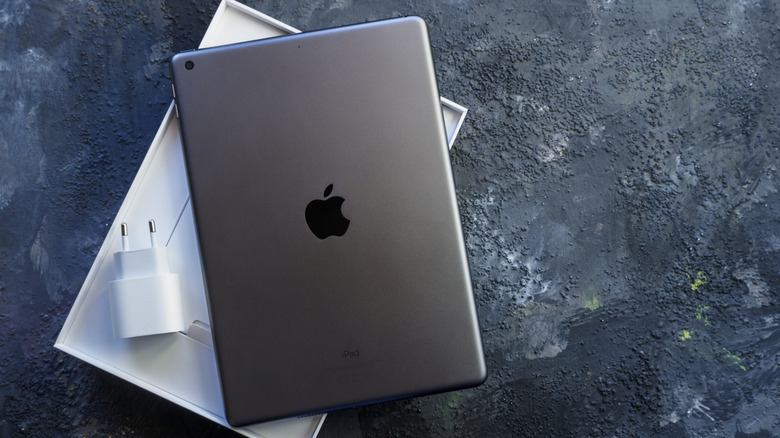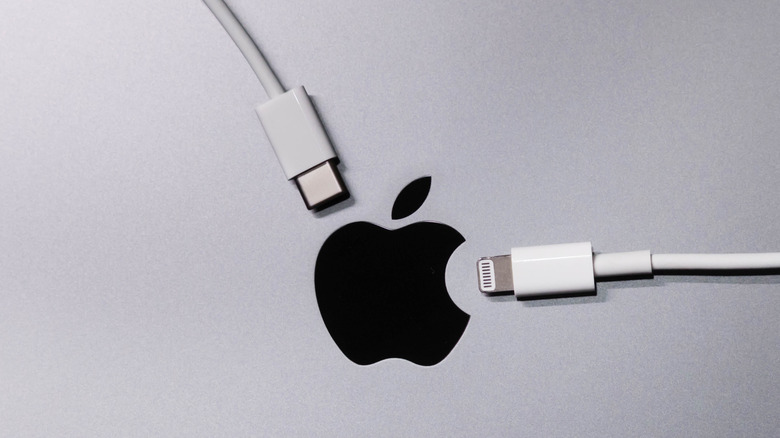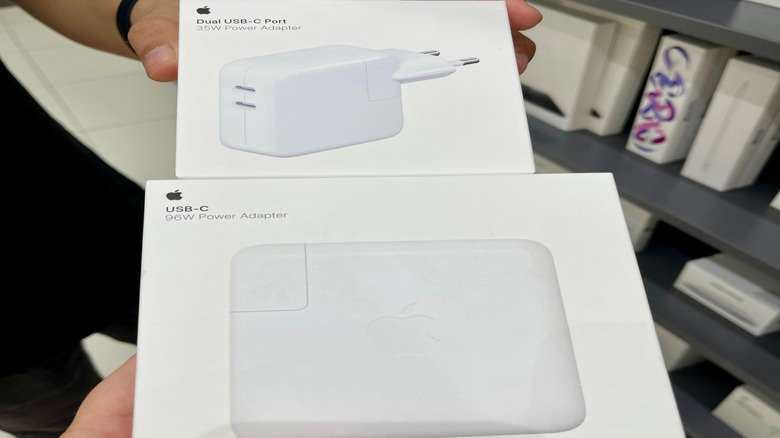Do All iPads Come With A Charger In The Box?
For devoted Apple fans, there was a time when its devices had everything you needed in the box, including earpods and stickers. While we've collectively accepted that the tech giant has stopped including the beloved Apple stickers with its iPhones, it has cut back in less cosmetic ways that have affected consumers. In recent times, most users are unhappy with Apple's decision to remove the AC plug with its latest iPhone releases, starting with the iPhone 12. And though it took a while, its iPad product line is going in the same direction.
Since the first iPad was announced in 2010, they have come with evolving types of charging cables: the 30-pin dock, Lightning Cable, and USB-C. While Apple has been using the USB-C charging system since the 12-inch MacBook Retina, which was released in 2015, it took a while before it appeared in its other devices. For iPads, it took three more years until the release of the 3rd-generation iPad Pro model (2018) for it to appear in the product line. In general, the move towards USB-C was a massive upgrade in terms of charging and data transfer speed, especially because Apple's official USB-C cables use Power Delivery technology. Not to mention, it offered a ton of advantages of longevity and possibilities to use products made by third-party manufacturers. But, which of its iPad models still come with a charger, does it affect all devices sold worldwide, and what pushed Apple to take it out?
Which iPad Models Come with a Charger?
For prospective iPad owners based in the United States, the good news is that it still comes with the charging brick. Based on the Apple website, all current iPad Pro, iPad Air, iPad, and iPad Mini models still come with the 20W Power Adapter. However, for those based in the European Union and the United Kingdom, it's a different story. Based on the iPad product listings from EU countries like Spain, France, and Italy, you can only expect to get the USB-C cable. Similarly, devices sold in the United Kingdom also don't have the adapter. As of writing, the entry-level variant of the iPad Pro in Spain starts at €1,199. If you factor in the additional €25 20W USB-C Power Adapter, the total cost will be about €1,224 or about $1433. In comparison, the same model with the adapter is sold for $999 (before taxes) in the US.
Knowing all this, it's unsurprising if you wait until a trip to the United States before buying your next iPad. Although, similar to the iPhone, there are other countries where you might be able to find a better deal. Apart from the AC plug inclusion, taxes and exchange rates can also affect overall pricing. But take note, you might encounter issues regarding international warranty coverage. But if you already own one adapter, you can use it for other Apple products and it won't be a problem unless you need to charge them simultaneously.
Why Apple removed its iPad charging brick
In compliance with EU regulations, Apple had to make a lot of changes with its device charging systems, including introducing the USB-C port, fast charging standardization, and offering ways to buy devices without chargers included. Unlike its first two types of proprietary chargers, which only work with Apple products, the USB-C is part of a universal charging system that works with a ton of other devices from other brands. Because of this, there's a lot more flexibility for people who prefer using third-party accessories, as well as long-term usage across devices.
Similar to how it removed the AC plug from its iPhone releases, it's also possible that doing the same with its latest iPad models helps its own environmental goals. In its 2025 Environmental Progress Report [PDF], Apple shared its goal of total carbon neutrality by 2030. Although one can argue that it may only be pushing the carbon footprint to its customers and generating more profit, since many new customers may still need to buy it separately. That said, if you're not fully satisfied with the existing charging experience, there's also a MagSafe-like iPad charger from a third-party manufacturer that you might want to consider. While it's not compatible with all iPad Pro models, there's a lot of promise that it can be your companion in the years to come. Apart from being compatible with the latest 2024 M4 models, it also works iPad models that date back as far as 2018.


